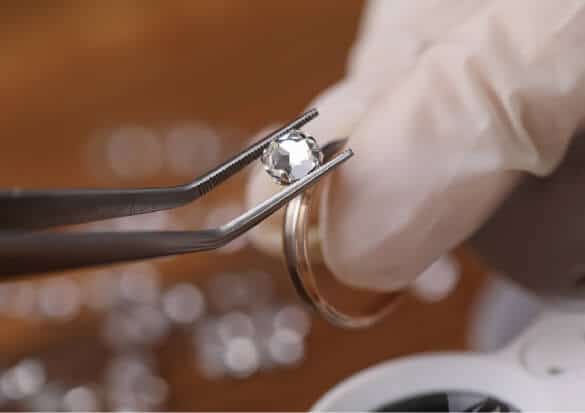5 Must-Knows Before Getting A Lab Grown Diamond Of Your Own
Posted on
Lab grown diamonds have been around for a while now, since 2005 to be exact, but only recently did they truly make an impact in the diamond market. Despite taking 2% of the consumer market for all diamonds, it is expected to grow 22% annually to reach $14.9 billion by 2035. Having established a strong presence, you can’t dismiss these lab grown diamonds as a viable contender for your ring finger.
Buying a diamond jewellery is a significant decision and it is something that people would want to do it carefully. Here are the 5 things you should take note before buying a lab grown diamond so you can make a more informed purchase.

1. The Formation of Lab Grown Diamonds
There are two methods by which a lab grown diamond is created: High-Pressure High-Temperature (HPHT) and Chemical Vapour Deposition (CVD). These two methods replicate the environment in which a mined diamond is grown and procured. The two conditions needed for diamond development are intense heat and extreme pressure; two conditions that were met in these two methods.
The HPHT approach replicates a natural geological process. It requires a diamond seed – a flat slither from another diamond – which is then placed in a HPHT diamond machine. The seed will be exposed to a temperature of about 1500 Degrees Celsius and pressurised to approximately 7.3 million kilograms per square metre.
The CVD approach involves putting the same type of seed into an airtight chamber. The high heat – approximately 800 Degrees Celsius – in this chamber, that’s also filled with carbon-rich gas, will cause the gas to attach itself to the seed, atom by atom.
Due to these two methods, lab grown diamonds are chemically, physically and optically identical to that of mined diamonds. For this reason, the Federal Trade Commission (FTC) had expanded the definition of diamonds and included lab created diamonds in the list. And instead of taking billions of years, lab grown diamonds only need weeks to fully form!
2. Quality Comparison
Seeing as how the development of these lab grown diamonds take significantly less time compared to a mined diamond, surely there must be concessions? Their identical chemical composition has been established, but what other similarities do they share?
These two diamond types achieve a 10 on the Mohs scale, which is an impressive feat that puts both of them as the hardest existing mineral. This translates to a high scratch resistance, which is an essential quality for the perfect gemstones for daily wear.
Despite having been created in a lab, the imperfections of these lab grown diamonds are actually a good thing! As the diamond seeds grow, the seed will trap impurities inside the lattice, which will give it a nuanced variety in saturation and hues. Just like mined diamonds, lab created diamonds have a colour grade range from D (colourless) to K (yellow undertone).
And similarly, lab created diamonds don’t cloud over time. You can thank the crystal structure and its durable nature for that. They have the propensity to shine for days and if there is a film build-up, it is nothing a little soap and warm water can’t fix!
3. Meeting The Stringent Requirements
Before a diamond reaches the display shelves, they are first assessed under the 4C diamond grading system. Formed as an accessible assessment method even for consumers, the 4Cs comprise of carat weight, colour grade, clarity grade and cut grade.
Likewise, each of Star Carat’s lab grown diamonds is graded under the same grading system. To concretise their top-notched quality even further, these diamonds are also certified by the International Gemological Institute (IGI). Furthermore, diamond testers have certified our exceptional lab grown diamonds as Type IIA diamonds. Due to their rarity and remarkable quality, Type IIA diamonds make up 2% of the mined diamonds in the industry. Who wouldn’t want to sport a rare stone on their finger?
4. Enjoy Significant Savings
Other than being relatively environmentally friendly, the affordable price tag has also managed to attract and intrigue many consumers. Lab grown diamonds are priced significantly cheaper than that of mined diamonds. A 1 carat Star Carat diamond ring shares the same price as a 0.4 carat mined diamond. Imagine paying almost 50% less and getting a gemstone that’s 50% bigger in return! If you desire to sport a magnificent engagement ring but have a budget to stick to, there’s nothing like a lab grown diamond ring to check both boxes.
5. The Up And Coming Choice For Consumers
Millennials and Generation Z comprise of young adults who, research has shown, no longer see mined diamonds as the only item with a romantic appeal. They’ve realised that several other types of jewellery that can not only meet their demands, but are also offer a more conscientious purchase.
Being more environmentally and humanitarian conscious, they would rather opt for lab grown diamonds than the more traditional offering of mined diamonds. In fact, studies have shown that nearly 70% of millennials are considering lab grown diamonds as an alternative. This isn’t surprising, seeing the enticing price tags that accompany these gems. It is for this reason why lab grown diamonds are especially attractive to those who have a budget they wish to abide by.
Regardless of its origins, diamonds have reigned supreme as the tangible embodiment of a bond between two individuals. Especially with the advancement of technology, there are now more options in which you can package your love as a gift.
With 30 solid years of experience in the diamond industry, you can trust us to gift you quality diamonds deserving of a magical love story. Shop for the perfect diamond with us at Star Carat Shop, SK Jewellery and Love & Co. today!
